![]()
![]()
![]()
Use LEFT and RIGHT arrow keys to navigate between flashcards;
Use UP and DOWN arrow keys to flip the card;
H to show hint;
A reads text to speech;
10 Cards in this Set
- Front
- Back

|
Hans von Reutlingen, Reliquary of St. Lambert, in Liège Cathedral, made before 1512, gold, silver, and gems. Commissioned by Bishop Erhard de la Marck
Gold sculptures in reliquaries and church treasuries often survive more often than in the inventories of noblemen, and were used to draw pilgrims, to make shrines look more important and raise status & prestige. |
|
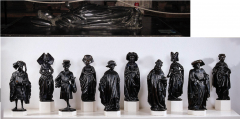
|
Jean Delemer, Tomb of Isabella of Bourbon, wife of Charles the Bold, 1476, bronze with black patina. In the abbey church of St. Michael near Antwerp
Bronze is often used for funerary tombs, as is the case with the tomb of Isabella. The reclining figure of Isabella is decorated by ancestors & relatives at the base. Nobility often had their body, heart and entrails buried in different locations as a sign of perpetual rule over a wide dominion, even after death. |
|
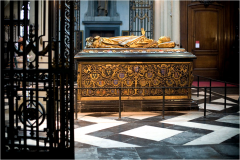
|
Tomb of Mary of Burgundy designed by Jan Borman (he carved the wooden model), cast in bronze by Renier van Thienen, and gilded by Pieter de Backere. Hubert Nonon did the stonework and polishing, and Jaques van Lathem the heraldry. 1488-96. In the Church of Our Lady in Bruges. Gilt bronze, enamel, and black Dinant marble.
Mary was the daughter of Isabella and wife to Maximilian of Austria. She died from wounds she got in a hunt. Her tomb is placed in front of the altar, one of the most privileged places to be buried. The tomb is depicted with a tree that has all the coat of arms of her territories. Her sculpture has much detail such as the skin of her praying hands, intricacy of headdress and clothes, etc. |
|
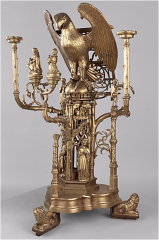
|
Brass lectern, attributed to Jehan Aert van Tricht, ca. 1500
Complicated but intricate design with lions on the base and an eagle, the symbol of John the Evangelist sits on the lectern. |
|

|
Altarpiece of Ministry and Passion of Christ, carved and polychromed wood, 1460s, commissioned by Claudio de Villa
Mary Magdalene is prominent the most in all three parts. Special commission that prob. Cost more money but also features the patron couple. Minute quality work shown such as the Book of Hours painted as if it were real. |
|
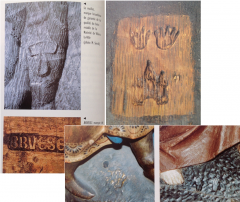
|
Guild marks guaranteeing quality of carved altarpieces: Brussels mark of mallet for wood, “Brvssel” for polychromy, and compass for carpentry; Antwerp mark of hand for carving and castle for polychromy.
|
|
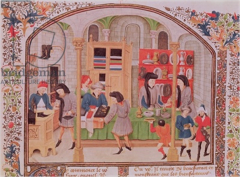
|
Aristotle’s Ethics, Politics, and Economics, illuminated by a Netherlandish master, c 1454-5, showing craftsmen’s stalls in a cloister
This is a show of money and depicts a cloister with many stores/stoles. Some sell finished products, others sell parts to be put together or supplies for artists to make their own works. This is also a show of how of the consumerism was already going on at the time. |
|
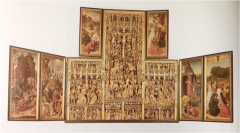
|
Passion Altarpiece, c. 1510, Antwerp-made, carved and polychromed wood. St. John’s Cathedral, s’Hertogenbosch.
There is much gilding involved in this scene depicting the Passion with older stories at the base, but what is important is the narrative detail on the small figures in different positions, faces and clothing. The external wings, which show scenes of the life & ministry of Christ is painted while the more important inner part is sculpted. |
|

|
Rogier van der Weyden, Exhumation of St. Hubert, late 1430s, oil on panel
This is a show of how works like altarpieces are integrated in an environment of a church with candles, incense with splendidly dressed priests, not in isolation in a museum. |
|
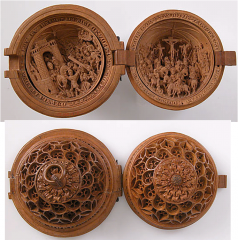
|
Rosary bead, boxwood, 1490-1525, Netherlandish
Beads came in all kinds of materials and designs. Some (more used as centerpieces or terminal bead) even opened up to reveal an intricate scene and engraved prayer on the interior. |

